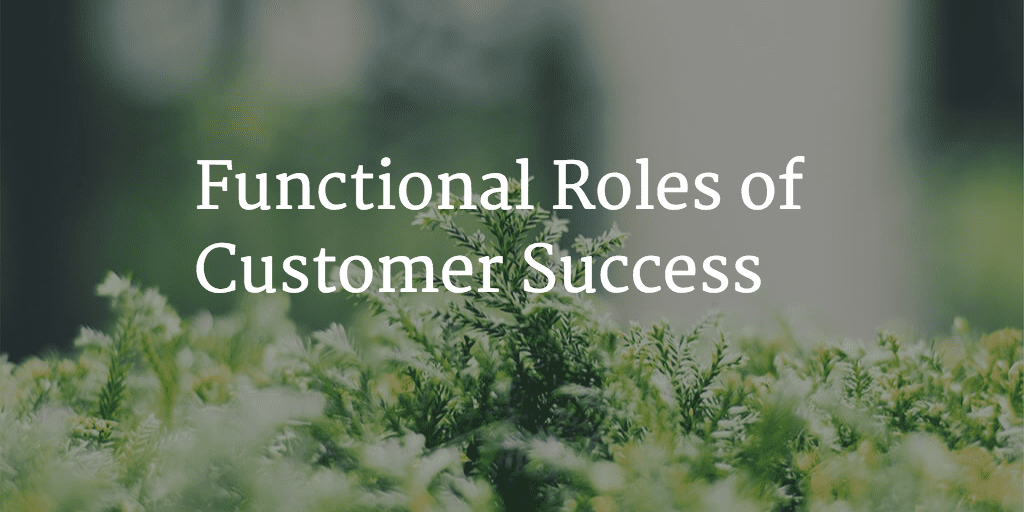Working in Customer Success Management is an interesting and varied job and often encompasses what may be in some companies, and perhaps yours in the future, multiple different roles. I’ll try to define some of those roles here.
Customer Success Management
This is the organization that is – at it’s core – responsible for customer retention, or prevention of churn. To achieve the end goal of driving up the renewal rate, it is not uncommon at all for Customer Success Managers (CSMs) to not just perform the duties of what we might see as pure CSM activities, but to take on the functions of other “functional roles” to drive product adoption and deliver product value.
Often these functional roles start under the CSM and, as needed, are spun-out into their own stand-alone, actual (rather than simply functional) roles and departments within the company.
Customer Support
One of the biggest misconceptions out there is that your best customers are the ones that never contact support. The reality is the complete opposite!
Healthy customers will actually call Customer Support with some degree of frequency, as they tend to push your product hard and do find the bugs and errors. Customer Support Reps are typically 100% reactive (they wait for customers to call) and are measured by how many tickets (Support cases) they close in a day, week, or month.
A little hack to determine whether the time is right for a stand-alone Customer Success team is to monitor the number of “how to” questions that come into Customer Support. By their nature, how-tos are not break/fix type questions meant for support, but actually have to do with product adoption, which should fall under Customer Success.
On-Boarding
Also known as Enablement or Implementation, this is the organization that is often the first to touch a customer after they sign a new contract. The On-Boarding folks are responsible for helping to provision/install/configure the product and to get the customer to a place where they can effectively use it. We could say that Implementation’s job to accelerate the Time to First Value (TTFV) for the customer.
The typical On-Boarding project can take anywhere from several days to several months (hopefully with some value being delivered long-before the process is “complete”), depending on the complexity of the the customer environment/needs/integrations/customizations/etc. This process often includes a Project Manager on both sides and many other players as well.
The team of people doing On-Boarding are often capable of, and may even be doing, consulting or Professional Services engagements for you as well. They are deeply skilled in the customization/configuration of your software. They may also have a high degree of expertise in using your software as well although that skill is usually left to the CSM.
Customer Training
Training can take a number of forms – classroom, live online, or On-Demand. The Training organization, if you have one, is possibly using all of these methods and more, to educate your customers (and internal employees, too). In a company where the training organization has not yet been formed, CSMs often take on this responsibility.
Even when training is more formalized and available, CSMs will still spend a majority of their time training, or retraining, customers. Honestly, training is the core function of a CSM because it’s the primary method for driving product adoption. And product adoption plays a massive part in driving high renewal rates.
Although CSMs are typically very skilled in the use of their products and adept at training customers to that same end, the Training organization, when it is formalized, will take the development of consistent training deliverables to the next level and may take on the responsibility for general user and administrator training while the CSM focuses more on the individual customer’s use cases.
Professional Services
Also known as Consulting or Solutions, these are the hired guns with very deep knowledge of your product, the domain, or some related expertise. They will typically engage with customers in a very specific area of need and charge for those projects. They are critical to the overall growth of your install base and your company because they bring in revenue while integrating your product(s) much more deeply into the customer’s infrastructure and processes.
This organization often develops out of a repeated need from your customers or may be driven by your company in order to deepen the ROI that your customers are getting. Your Professional Services organization will be measured on overall revenue contribution to the company and, within the organization, on the percentage of available hours that are billable to a customer (called Utilization in consulting parlance).
Renewals
In a company where a signed contract is required at the end of every contract term, someone needs to be responsible to secure that contract. This team is usually called the “Renewals Team.” In many cases, the people doing renewals may also be responsible for upsell and cross-sell, too. Just like the other functional roles listed here, CSMs may take on the renewal responsibilities at first, but this may eventually be spun-out into a stand-alone Renewals team.
On the other hand, the “Renewals Team” may fall under Sales – or might be Sales – so the CSM organization doesn’t own the actual function of renewing a customer. Instead, they just own process of ensuring the customer is successful over their lifetime with your company so renewal becomes a non-event. Just.
Upsell or Install Base Sales
- Find an existing, successful customer
- Get them to pay you more to use more of your product (more seats, add-ons, etc.)
- Profit
The most efficient growth comes from up- or cross-selling to your existing customer base. I’m not sure that’s ever been up for debate.
What is quite often up for debate is where this responsibility to sell additional products and/or services to existing customers falls. Does the CSM organization do this or does this fall under Sales or traditional Account Reps?
The reality is, at least for now, how this is done varies widely across companies and there’s no consensus on the best way to do it. At some companies, this responsibility lies with Customer Success Managers while at others, the Renewal team may take this on. Another organizational option is to have a completely separate Sales team that is focused exclusively on selling to existing customers. This would typically not happen until the install base is of a significant size.
No matter who owns sales to the existing Install Base, the fact that the CSM organization has a direct impact on the ability of your company as a whole to expand revenue by selling more to existing customers is not debatable. From improving the success of your customers, to surfacing opportunities for expansion sales within your install base, the CSM organization is often the engine behind the up-sell machine in your company.
I hope this helps you better understand the different functional – and perhaps real – roles you’ll either perform or interact with as a CSM.
If you’d like to take your Customer Success Career to the next level, enroll in Customer Success University now.


